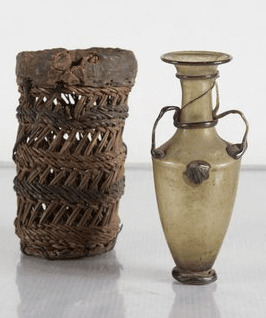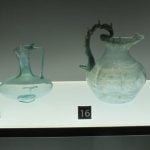Chapters
Preserved objects show that the ancient Romans were excellent craftsmen, working with a variety of materials: from leather, fabrics, wood to metal and glass.
In some areas, pottery was developed on a mass scale, with large workshops producing millions of wine amphorae and red vessels called terra sigillata. Many potters were slaves or freedmen, and surviving signatures show that men mainly carried out the craft. Other types of crafts developed on a smaller scale, with craftsmen usually working in their own workshops in the cities. Skills were acquired over many years of practice and experience. Sons learned from their fathers, slaves from their masters or predecessors; craft colleges (collegia) were also established. Particularly talented craftsmen, even if they were slaves, could make a fortune by fulfilling special orders for wealthy clients.
Glassmaking
Glass had been made for centuries, but it was not until the 1st century BCE that someone came up with the idea of blowing it. Thanks to this, many forms of utility vessels could be made faster and cheaper. Soon, the technique of blowing glass into moulds was learned, which enabled mass production of various bottles and intricately decorated flasks. Glass ceased to be a luxury and became a commonly used material. Just as today, cullet was often collected and reused.
Metal products and jewelry
Roman craftsmen often worked in gold, silver, lead, copper and iron. They were able to extract ores, obtain metals from them, melt them and pour them into molds, although they did not invent furnaces (the Romans used bloomeries) for smelting pig iron and could only forge it while hot. Metals were mixed to obtain alloys, for example bronze – an alloy of copper and tin. Roman brass also contained zinc, which gave it a golden color. Fragments of old necklaces, bracelets and rings were melted down and made into new ornaments.
Bone products
In the ancient world, bone was what plastic is today. Bone was used to make everyday objects such as knife and sword handles, hairpins, and combs. Bone brought from the butcher could be beautifully carved and inlays made to decorate wooden boxes. Bone was also often used to make game pieces.
- Roman glass amphora and basket
- Roman bone comb









